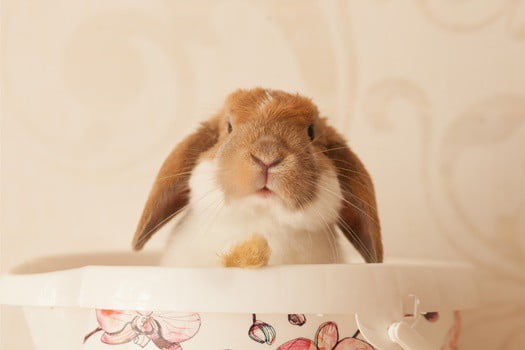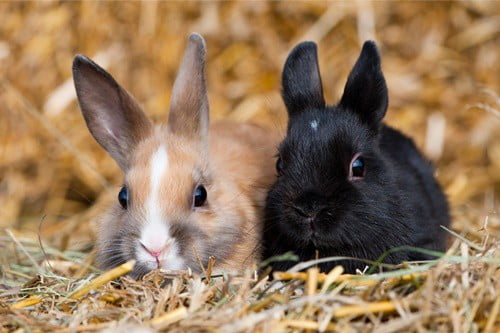Due to the large variations between rabbit breeds, size, and weight at adulthood, there are many variations between the times at which certain breeds are sexually mature. On average, smaller breeds reach sexual maturity faster than larger breeds.
A small breed rabbit female can get pregnant at 4-5 months, and a male rabbit is ready to breed at 6 months. A medium-size female is ready to breed at 5-6 months and a medium buck at 7 months. A heavy breed doe is often ready at 6-8 months, and a heavy buck reaches sexual maturity at 9 months.
The gestation period (the time between breeding and kindling) is on average 31 days. Once a rabbit doe has kindled, she is ready to breed again after 6 weeks. While selecting rabbits to breed, its advisable to choose a breed with ancestry that has evidence of good genetics and productivity.
At What Age Can Female Rabbits Breed?
| Breed Size | Age Rabbits Reach Sexual Maturity |
|---|---|
| Miniature Breeds (e.g. Netherland Dwarf, Polish Dwarf Hotot, Britannia Petite, Holland Lop) | 125-150 days |
| Medium Breeds (e.g. Florida White, Mini Lop, Dutch, Havana) | 150 to 180 days |
| Large Breeds/ Commercial or Standard Breeds (e.g. New Zealand, Champagne d’ Argent, Californian, Palomino) | 6 to 7 months Depending on the breed, commercial breeds will sexually mature at 9-10 pounds of body weight |
| Giant Breeds (e.g. Giant Chinchilla, Flemish Giant, Checkered Giant, French Lop) | 8 months Giant breeds don’t reach complete physical development until this age |
The average female becomes sexually mature at 3 to 8 months of age, depending on her breed, size, and body weight. She can conceive at any time of the year for the entire duration of her life. However, egg and sperm production decline after 3 years of age, according to Reproduction Toxicology.
During mating, the rabbit buck will mount the rabbit doe from behind, insert himself into the female and perform rapid pelvic hip thrusts. This encounter will last only 20-40 seconds, after which the buck will throw himself backward off the doe.
The gestation period in rabbits is short and ranges from 28 to 36 days (average 31 days). Longer gestation periods lead to smaller litters, whereas shorter gestation periods yield larger litters.
The size of a litter can range from 4 to 12 rabbit kits. Female rabbits can give birth to up to 60 rabbit kits per year if living conditions are ideal. Following birth, a female rabbit can get pregnant as early as the next day.
Unfortunately, the mortality rates of rabbit embryos are high. This is often due to trauma, infection, environmental stress, and poor nutrition. Therefore, a high fertility rate is imperative to counter this.
Signs Your Rabbit is Pregnant
Once a rabbit reaches sexual maturity, it can begin to produce offspring. If an intact female and intact male were left together, and both were over 3.5 months in age, you will have to monitor the female for any signs of pregnancy.
Nodules In The Belly
Like most mammals, a pregnant doe’s belly will get bigger as her babies grow and develop inside her womb. Therefore, a growing belly is a visible sign of a rabbit being pregnant.
10-12 days after breeding, you may be able to feel multiple marble-sized bumps inside your doe’s tummy. These tiny bumps are the baby rabbits inside your rabbit’s belly, and they’ll be big enough for you to feel.
The bumps will continue to grow inside your rabbit for another 2 weeks or so, until its time for your rabbit to give birth (about 1 month after breeding).
Behavioral Changes
Pregnant rabbits eat more and are often more irritable and moody. However, if your rabbit is usually reserved or unfriendly, it may be hard to determine that she is pregnant based on her mood alone.
Nesting
The most noticeable sign will be your rabbit starting to prepare a nest. She may begin piling up bedding or digging into a corner of the cage.
A rabbit will usually pick up hay or other items that can be carried in the mouth to make a comfortable space for her to give birth. She may also push loose bedding together or push blankets.
What’s most alarming to owners who haven’t bred rabbits before is a nesting rabbit pulling out her own fur to line the nest. This is completely normal.
If your rabbit is nesting, expect her to give birth within one week. If she starts pulling her fur out, she’s probably going to give birth within the next 1 to 2 days.
Most rabbits give birth at night, so anticipate waking up to a litter of kits.
If your pregnant rabbit hasn’t given birth after 35 days of breeding, contact your veterinarian as soon as possible. Your vet will either induce labor or have the babies removed via surgery.
A pregnant rabbit may show nesting behavior about a week before she is ready to give birth.
Rabbit Labor
A rabbit’s gestation period is generally between 28 to 36 days, with 31 days being the average.
When a rabbit gives birth, it is called kindling. Kindling occurs at night or in the early hours of the morning and takes around 15 minutes.
The process of giving birth is instinctive, so they rarely need human help during the delivery.
Once you’ve checked all the babies, leave your rabbit’s nest alone for the first few days. Disturbing a mother rabbit’s nest can stress her, which may stop her from feeding her offspring.
Rabbit Litters
Rabbit young are referred to as kits, and each litter can have 1-14 kits, with 6 being the average. Kits are born blind, hairless, and deaf. 10 days later, they will begin to develop properly.
The mother rabbit will nurse her kits once every night according to the Biology of Reproduction.
Nursing takes around 5 minutes only because of the high energetic value of the mother’s milk, as indicated by a study published in Animal Reproduction Science.
Rabbit kits are fully weaned when they’re 4-6 weeks old. Continue to keep your female rabbit separate from the males. A female rabbit can become pregnant again just hours after giving birth.
False Rabbit Pregnancies
Although rare, some rabbits do experience false pregnancies. A rabbit with a false pregnancy may show typical pregnancy behaviors, such as nesting.
If you suspect your rabbit has a false pregnancy, take her to a vet. If you don’t want your rabbits to get pregnant, it is highly recommended that you get your rabbits spayed or neutered.
Why You Shouldn’t Breed Your Rabbits
It’s easy to forget that rabbits are a prey species when we get them as companions. Like other prey animals, rabbits continue to produce offspring to keep their species alive and counter high predation in the wild.
However, in the case of domesticated animals, breeding may create the problem of too many rabbits.
Rabbits differ from other mammals because female rabbits ovulate after being mounted by a male — a process called induced ovulation. This is the only time a rabbit doe produces an egg.
What this means is that once a rabbit gives birth, there’s a high chance she will become pregnant again if a male is still present. A rabbit can get pregnant as early as a few hours after giving birth.

Rabbit Breeding Problems
Pregnancy-related problems are far more severe when a rabbit is young while giving birth. Regardless of age, the following are some common problems that may occur if a rabbit gets pregnant.
- Your rabbit may be confused and may not build a nest for her babies, causing the newborn kits to die of exposure.
- Your rabbit’s milk may not form or she may be unable to feed them.
- There’s an increased risk of rabbit kit mortality, particularly if they are hand-fed by humans.
- If the father was a larger breed than the mother, the mother may have difficulty while delivering babies and die during labor.
- If the mother isn’t healthy, she may get sick due to the stress of carrying and giving birth to her babies.
If you do let your rabbits breed, have a set plan for the 4-12 surviving offspring. You may decide to either find caring and responsible homes for them or take care of them yourself.
If you do decide to keep them, understand that they will be your responsibility for the next 8 to 10 years. You’ll also have to spay and neuter each of them.
Any rabbit that is born either through planning or by mistake is taking a home away from a rabbit in the shelter. Several rabbits die every year as a result of not finding homes.
Therefore, if you are looking to add more rabbits to your family, consider visiting your local shelter. See if other rabbits desperately need homes.
Why You Should Spay Or Neuter Rabbits
Ideally, you should be spaying or neutering your rabbits. Female rabbits that have been spayed live longer because you eliminate the risk of mammary, ovarian, or uterine tumors.
Male rabbits are far less aggressive, fight less with their hutch mates, are less territorial and more reliable once they have been neutered.
More importantly, rabbits that have been neutered or spayed cannot produce unwanted litters. This helps control the number of homeless rabbits in shelters.
Rabbit Breeding Principles
Keep the following principles in mind if you want to breed your rabbits:
- Breed rabbits of the same breed. You cannot sell pedigree rabbits with mixed blood in its background that goes back 4 generations.
- Avoid keeping rabbits in the same cage if they’re 3 months or older. Rabbits mature faster, do not breed and do not fight when alone, thereby eliminating unwanted results.
- Check the bottom of the cage for signs of loose stools or diarrhea. Never breed a rabbit with this condition until it has been treated fully.
- Check signs of disease/infection in the genitals of both rabbits. Look out for red flags such as severe redness, soreness, discharge, or scabbiness.
- Take the doe to the buck’s cage. Doing it the other way around will reduce the buck’s tendency to breed as he’s too busy sniffing around the doe’s enclosure.
- If you decide to remove your doe after your rabbits have mated, place the doe back with the buck 1 to 12 hours after breeding. This increases the likelihood of pregnancy and increases the number of offspring.
- Record the day you breed your doe in a calendar and test her for pregnancy by the 10th to 14th day of the initial breeding.
- To test your rabbit’s pregnancy, palpate her lower belly with your thumb and forefinger. You should feel marble-sized bumps.
- Place a nest box next to the mother rabbit’s cage on the 29th day after breeding.
- Never breed closely related pairs, such as brother and sister, mother and son and father and daughter.
Avoid checking your rabbit’s pregnancy by mating her again. Not only is this method more inaccurate, but it’s also risky for your rabbit and her offspring’s lives.
Female rabbits have two uterine horns. Both horns can carry babies. When you breed your rabbit doe once, her first horn gets fertilized. Breeding her twice causes her second horn to be fertilized. This creates a hormonal imbalance.
Hormonal issues can affect the development of the babies, causing the mother rabbit to pass blobs during her kindling. On some occasions, this may also reduce the mother’s chances of survival.

